GW&K Global Perspectives — December 2023
A Closer Look at the US Budget Deficit: Understanding the Size of the Challenge
Highlights:
- The US budget deficit unexpectedly doubled in the past year to $2 trillion, even as pandemic emergency spending faded.
- Deficits averaging $2 trillion per year over the next decade now look likely, driven by an aging population and strong entitlement growth.
- This outlook poses fiscal sustainability challenges, requiring comprehensive reforms to federal spending and revenues.
Deficit Balloons to Unprecedented Peacetime Levels
The US budget deficit has surged to concerning levels outside of economic crises or wartime. Last year’s $2 trillion deficit was twice as high as 2022’s $1 trillion figure (Figure 1).1 Typically, such high deficits occur during recessions or wars. However, the current deficit ballooned amid relatively healthy economic conditions.
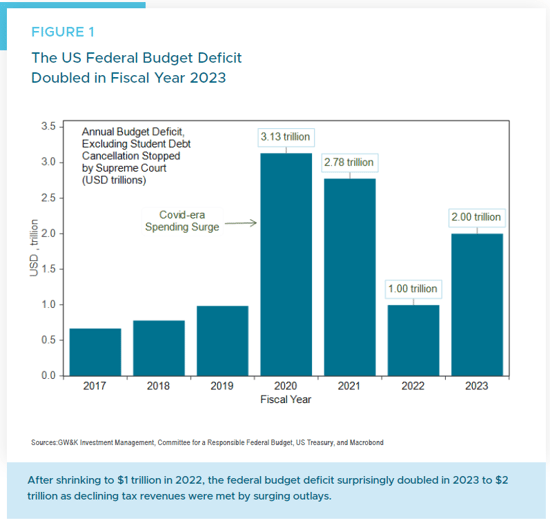
This gap reflects a large imbalance between spending and revenues. Last year the government spent approximately $6.4 trillion against $4.4 trillion raised. Major entitlement programs like Social Security, Medicare, and Medicaid account for significant spending growth. These vital yet expensive programs strain budgets.
Pandemic Spending Recedes, Deficits Remain
Pandemic emergency relief further expanded deficits. As pandemic impacts fade, why haven’t deficits likewise normalized? The answer lies in entitlements, rising interest costs, and lagging tax revenues, filling fiscal space left by reduced pandemic aid.
The government unleashed substantial pandemic spending from 2020 – 2021, with $5 trillion spent combatting Covid’s economic fallout. This emergency relief was critical but added to fiscal strains not yet resolved.
Initially deficits fell in 2022 as emergency spending declined amid a strong economic recovery. However, 2023 brought a new reality: Fading pandemic relief was overshadowed by growth in major entitlements plus rising interest expenses. Lower tax receipts were also a factor following sharp losses in stocks and bonds in 2022.
Aging Population Drives Budget Pressures
Beyond the pandemic, an aging population fundamentally alters spending (Figure 2). Rising Social Security, Medicare, and Medicaid costs, stemming from more beneficiaries and higher per-person healthcare expenses, dominate budget outlooks. This poses sustainability challenges necessitating comprehensive reforms.
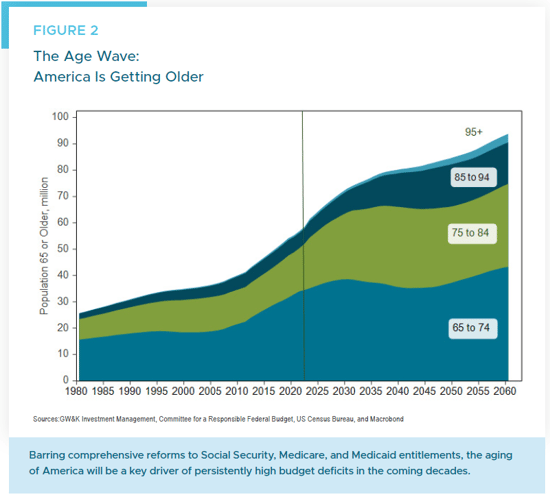
Firstly, more Social Security beneficiaries increase costs. As more baby boomers retire, the ratio of workers funding benefits through payroll taxes falls, heightening per capita expenses. Additionally, 1970s-era formulas link benefits to wage growth, elevating costs further.
Analyses show Social Security faces risks: its trust fund may deplete by the early 2030s (Figure 3). Barring remedial action from Congress, that will trigger abrupt benefit cuts for vulnerable retirees.
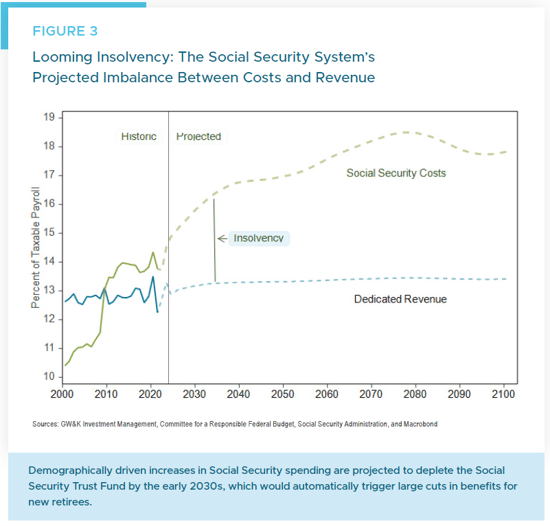
Similarly, Medicare and Medicaid costs grow with an aging population requiring more healthcare at higher prices (Figure 4). Medicare finances more beneficiaries while also covering older individuals needing extensive services. Medicaid provides long-term care critical for many elderly.
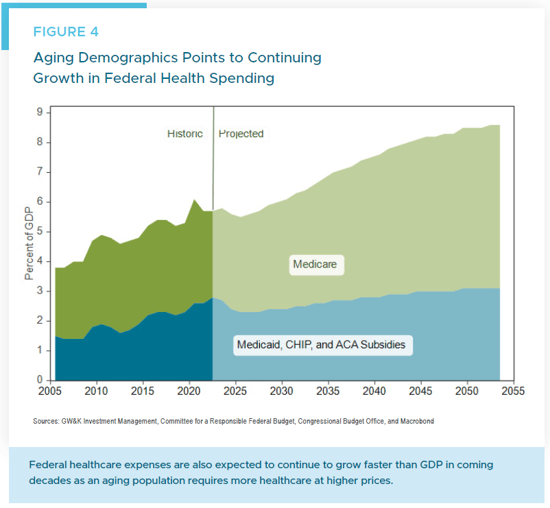
Tax Cuts Undercut Revenue Generation
Recurring tax cuts have eroded revenues needed to fund spending. While providing short-term relief, this pattern hampers long-term fiscal health.
Historically, revenues averaged around 17.1% of GDP — though cuts have now lowered levels nearer to 16.3% (Figure 5). With entitlement spending rising, revenues fail to keep pace.
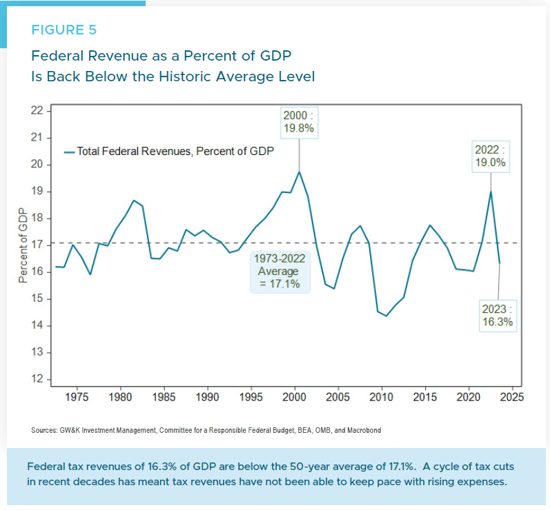
Politically, tax cuts may be expedient but contribute to surging deficits during times of fiscal duress. This dichotomy poses challenges for policymakers balancing short-term political wins and long-term fiscal discipline.
Bleak Deficit Outlook Through the Next Decade
Deficits may moderate slightly next year but will likely remain extremely high, averaging around $2 trillion annually for the next decade.
A modest deficit dip could occur next year as emergency outlays wane and revenues stabilize. However, deficits are likely to rapidly rebound, driven by entitlement and interest payment growth amid structural budget imbalances.
Specifically, the Congressional Budget Office (CBO) projects $2 trillion average deficits from 2024 – 2033, stemming primarily from Social Security, Medicare, and Medicaid expansion.2 This would push the federal debt to a record level of 119% of GDP by 2033, eclipsing the previous record of 106% set after World War II (Figure 6).
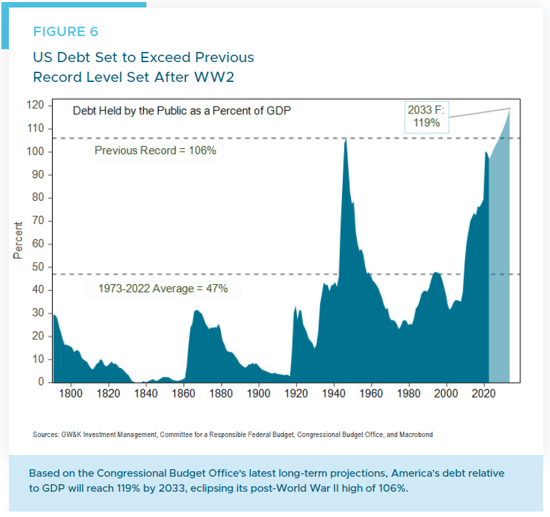
Moreover, rising interest costs on growing debt levels could further exacerbate budget strains.
Surging Interest Costs Heighten Risks
This scenario raises concerns around long-term fiscal sustainability and economic impacts. Comprehensive reforms to revenues and spending appear necessary to address deficits’ structural drivers.
Additionally, as rates rise off historical lows, interest costs consume larger portions of budgets. Around 2026 interest may surpass defense and Medicare as the second-largest budget expense given elevated interest-rate and debt levels.3
The CBO has warned for years about the heightened risks of high and rising federal debt. Their list of concerns includes:
- Higher borrowing costs crowding out private investment and slowing economic growth,
- Higher interest payments to foreign holders of US debt and,
- A possible fiscal crisis, in which investors lose confidence in the US government's ability to service and repay its debt
Major Rating Agencies Are Concerned
Against the backdrop of such concerns, the three major rating agencies have all expressed concerns about US debt. In early November, for example, Moody’s changed its outlook on the US credit rating to “negative” from “stable” citing large fiscal deficits and a decline in debt affordability.4
Moody’s did not adjust their current triple-A rating for the US government but noted that “continued political polarization within US Congress raises the risk that successive governments will not be able to reach consensus on a fiscal plan to slow the decline in debt affordability.”
Moody’s is alone among the three major rating agencies to maintain a top rating for the US government. Fitch changed its rating from triple-A to AA+ in August after months of political brinksmanship around the US debt ceiling. That put them in line with S&P, which has maintained an AA+ rating since 2011.
Rating agencies’ concerns have been dismissed by prominent economists as “bizarre and inept” and have typically had little impact on bond prices in the very deep and liquid market for US Treasury securities.5
A common argument is that the government’s ability to print money virtually guarantees its ability to service its debts, even if that creates inflation risks.6 However, credit agencies must consider willingness in addition to ability to pay. Recent debt-ceiling brinksmanship raises willingness questions.
Addressing the Scale of the Challenge
Proposed solutions illustrate the scope of deficit challenges. For example, the non-partisan Committee for a Responsible Federal Budget (CRFB) suggests $7 trillion in deficit reduction over a decade just to stabilize debt-to-GDP levels (Figure 7). Approximately 40% stems from revenues, 60% from spending reforms.
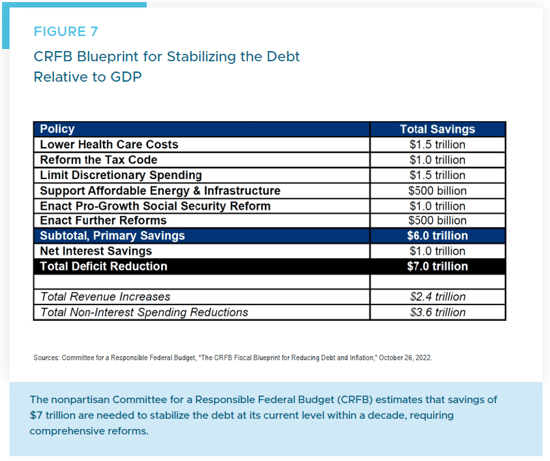
To significantly curb deficits, comprehensive measures touching all aspects of taxation and spending appear necessary, with no “sacred cows” exempted. Piecemeal changes to narrow areas prove inadequate to the task at hand.
It remains to be seen whether an intensely polarized US Congress will ever be able to constructively address the debt sustainability issue. And recent brinksmanship on the debt-ceiling issue leaves plenty
of room for doubt.
However, there are clues suggesting comprehensive reforms eventually may be possible: recent bipartisan deficit-reduction legislation, centrist coalitions emerging, and the 2030s Social Security reckoning that could change politicians’ calculus.7
Conclusion: "Americans Will Always Do the Right Thing..."
The good news is that the recent rally in the US bond market suggests that the risk of a fiscal crisis anytime soon appears to be low despite the current large amount of federal debt. The long-term fiscal challenges we have reviewed are well understood and largely discounted by sophisticated market participants. Such concerns typically have little bearing on near-term bond market pricing, which tends to respond more to economic data and expectations of Fed policy.
Moreover, despite the stridency of the CBO’s debt sustainability warnings, the CBO has clearly stated that it “does not have sufficient information to reliably quantify the probability of a fiscal crisis” and that “no tipping point can be identified at which the debt-to-GDP ratio would become so high that it made a crisis likely or imminent.”8
Accordingly, we would caution investors about overreacting to long-term debt sustainability issues. Keep in mind the example of Japan, with much larger debt and demographic challenges, which has nevertheless maintained among the lowest inflation and interest rates in the world for many years.
That said, rising interest rates and debt levels alongside demographic changes raise legitimate deficit and debt sustainability concerns. This topic seems likely to dominate American politics for years.
To conclude on an optimistic note, we take some comfort in what Winston Churchill famously said about how Americans confront challenges: “Americans will always do the right thing...after exhausting all the alternatives.”9
William P. Sterling, Ph.D.
Global Strategist
1 Many of the projections used here were sourced from Marc Goldwein, “CRFB Webinar: R versus G and the National Debt,” Committee for a Responsible Federal Budget (CRFB), October 12, 2023. Additional insights on this topic can be found in Bilal Hafeez, “Ep. 189: Marc Goldwein on the Unprecedented US Budget Problem and How to Fix It,” Macro Hive Podcasts, November 10, 2023.
2 Congressional Budget Office, “The 2023 Long-Term Budget Outlook”, June 2023.
3 This projection assumes that the average interest rate on debt held by the public is 1.1% higher than the 3.0% rate assumed by the CBO for 2024 – 2033. See Marc Goldwein, “CRFB Webinar: R versus G and the National Debt,” Committee for a Responsible Federal Budget, October 12, 2023.
4 See Alan Rappeport, “Moody’s Changes U.S. Credit Outlook to ‘Negative’,” New York Times, November 10, 2023.
5 See Shannon Thaler, “Larry Summers Joins Outcry over Fitch Downgrade: ‘Bizarre and Inept’,” New York Post, August 2, 2023.
6 For example, longtime Fed Chair Alan Greenspan once noted “The United States can pay any debt it has because we can always print money to do that. So there is zero probability of default.” Warren Buffett echoed this argument in 2020. See Ethan Wolff-Mann, “Warren Buffett Explains the Simple Reason the US Will Never Default on Its Debt.” Yahoo Finance, May 5, 2020.
7 For example, the Fiscal Responsibility Act of 2023 is estimated by the CBO to result in $1.5 trillion in deficit reduction in the 2023 – 2033 period. Also, centrist Senators Mitt Romney of Utah and Joe Manchin of West Virginia recently introduced a bill that would create a bipartisan, bicameral commission tasked with stabilizing the national debt.
8 Congressional Budget Office, “The 2023 Long-Term Budget Outlook”, June 2023, page 9.
9 Perhaps he never did say that but it’s a great quote, nevertheless. See “Americans Will Always Do the Right Thing – After Exhausting All the Alternatives,” Quote Investigator, November 12, 2012.
